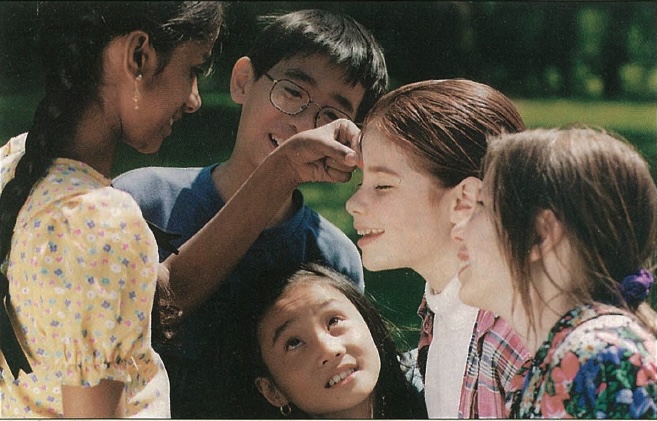By Archana Dongre
On the heels of the racist “dot buster” incidents which occur in major US metropolises, a refreshing 35-minute docudrama, Just a Little Red Dot (Sandalwood Productions, Ontario), aims to make a difference. Viewing it is an illuminating experience for adults. But even more heart-warming is the fact that it has turned elementary-school children into ardent anti-racism activists. The young stars of the film now travel far and wide, giving presentations on tolerance and acceptance to other kids in formative years.
The docudrama sprang from the real-life experiences in the 5th grade classroom of film-maker-turned-teacher Mitra Sen. It all began at the Tom O’ Shanter junior public school in Scarborough, Canada, on May 20, 1994. A new student from Sri Lanka, Parvathi, was jeered by other kids for wearing a bindi on her forehead. Later when classmates gave birthday presents to their teacher, Parvathi offered a package of bindis, and Sen wore one, explaining its cultural significance to her charges. Hearing that it would beautify them, the girls asked to wear one, and then they ran out to the playground with their bindis on.
Their artless enthusiasm was quickly crushed as their peers hurled names at them, including slurs like “Paki-dots.” Stunned, ashamed and confused by their first-hand experience of rampant racism, even before understanding what the term meant, the nine-and ten-year-olds quickly and begrudgingly removed their bindis.
As Sen persuaded them to discuss it, some wise kids came up with the idea of “educating” their schoolmates about tolerance and respect for others’ cultures and appearances. They successfully popularized the bindis on the school grounds by cleverly calling them “cool dots.” Other women teachers also donned the dots, and despite initial obstacles, the teasers soon fizzled out as the new schoolyard fad mushroomed.
Sen, now in her thirties, had two years’ previous experience as assistant director for the hit TV series Degrassi Junior High. She saw in the bindi events fertile ground for an educational film. “My niche is to send out positive messages about multifaceted human rights issues, such as child labor and the tremendous abilities senior citizens and children have to contribute. I also have a strong affinity for my culture,” elaborated Sen in an interview with Hinduism Today. She now lives in Toronto, although she was born in England and brought to North America as a two-year-old by her Bengali parents.
Impassioned by the challenging project, Sen went on an unpaid two-year leave of absence, sought funding, then wrote, directed and produced the film. She recruited 80 children from more than a dozen national and racial backgrounds and turned them into actors. When the Red Dot premiered at the Ontario Science Center on June 25, 1996, the cast and directors earned a standing ovation, not just for the hearty, upbeat message, but also for the notable characters, graphics and an outstanding musical score by Ron Korb.
“This powerful film inspires, informs, heightens awareness and encourages the kind of respect, sensitivity and positive action so essential for our multicultural society,” remarked Dr. Karen Mock, national director for Human Rights of B’nai B’rith of Canada. Accolades from top government officials rained in along with public praise. Dozens of prestigious awards followed, for the film, for Sen, and also for the Little Red Dot Club, which was established on the kids’ initiative in the summer of 1996.
“Our goal is to make our generation realize the importance of sharing and understanding different cultures, so that when we grow up, we will know how to cooperate with all people no matter what they look like or where they come from,” Mandy Pipher, 13, co-chair of the club, explained to Hinduism Today. The five-member club has made some 60 presentations to elementary schools in metropolitan Toronto. “I love to see the impact on the kids. They come to me later asking for the cool dots,” beamed Pipher. It is an enhanced and intense learning experience for the club kids, who are becoming well versed in planning, public speaking and speech writing, not to mention the project’s flip side of applying for grants, preparing a budget, designing logos and formatting their first upcoming newsletter this summer. In December of 1996, the club received a $10,000 “Get up and Stand Up” grant from Trillium Foundation. The club also became a finalist for the “Leading anti-racism organization in Canada.”
Meanwhile, Sen is planning another sabbatical in the fall of ’98 to finish a teacher’s guide to accompany the film. “Then I will go to India, interact with children in villages and follow my other passion of photography,” Sen said. She has already been to India five times, and intends to do a film on Indian architecture, landscape, forts, medieval and rural settings and costumes. And if she finds racism and discrimination within India? Maybe she will change that, too, one day.
Just a Little Red Dot, Sandalwood Productions, Distributed by International Tele-Film, 5090 Explorer Drive, Suite 301, Mississauga, Ontario l4w 4t9 Canada. Tel: 905-629-3133; Fax: 905-629-1211.
